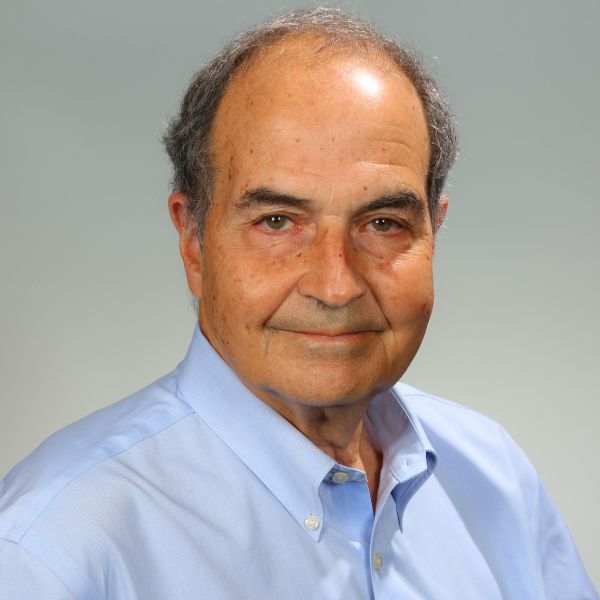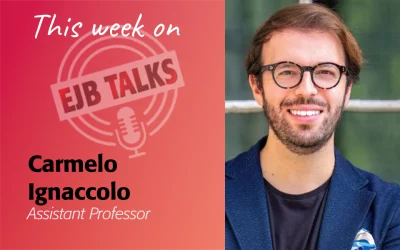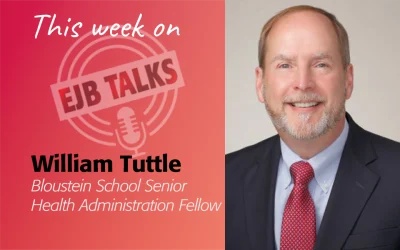Professor David Listokin, a distinguished professor in our internationally-ranked urban planning program, joins Stuart Shapiro in today’s episode of EJB Talks. In a wide-ranging discussion, they cover the nationwide span of David’s work. They discuss Professor Listokin’s upcoming book on the demographics and population trends of New Jersey. This project gave the researchers a better understanding of the significance of the current reverse migration trends which could have major nationwide impacts. Professor Listokin also discusses a long-time passion, his work for the National Parks Service on the economic impacts of historic preservation activities on Route 66.
Stuart Shapiro
Welcome to EJB Talks. I’m Stuart Shapiro, the Associate Dean of Faculty at the Bloustein School, and the purpose of this podcast is to highlight the work my colleagues and our alumni in the fields of policy, planning, and health are doing to make the world the country and New Jersey a better place.
Today, I’m very happy to be speaking with Professor David Listokin, a distinguished professor in our world-ranked urban planning program. Welcome to the podcast David.
David Listokin
I am delighted to be here.
Stuart Shapiro
Let’s start by talking about your upcoming book on the demographics of New Jersey, which you’re writing with our former dean, Jim Hughes. Can you tell me a little bit about the book and a couple of things that surprised you in researching it?
David Listokin
Sure. The book project started about three years ago, it was supposed to be a one-and-a-half-year project. So that speaks for itself.
Stuart Shapiro
Projects work that way.
David Listokin
Yes, yes, they do. Hopefully getting better with time like vintage wine. It’s entitled, as Stuart mentioned, “Population Trends in New Jersey”. And that’s pretty much what the book is about. 13 chapters, a number of appendices, about 250-300 pages. We’re currently in page proofs that will go to galleys, and hopefully, the book will be out before the turn of the year.
Stuart Shapiro
So did anything surprise you as you were researching it?
David Listokin
Oh, my. Where does one begin? And I love rabbit holes. So you know, you start at one point, then you find other things. What were some of the surprises? Well, colonial demography, which I knew nothing about, you know, New Jersey is a colony. So in contrast to today’s baby bust, the average household size in colonial New Jersey was seven. So that tells you something.
Slavery. New Jersey was the last northern state to abolish slavery.
Stuart Shapiro
Wow.
David Listokin
And it was the only northern state to enforce The Fugitive Slave Act.
Stuart Shapiro
Oh my.
David Listokin
You know, not a proud history. Actually, New Brunswick was at the center of the Fugitive Slave Act. When you had people, slaves fleeing the south, going north, coming through New Jersey, New Brunswick was a travel point, and they would plant themselves here. Sorry, I think that’s something you will have to think about.
Another surprise, immigration. While New Jersey tracked the nation, the Garden State did so on steroids. If I can just share a factoid or two. In 1910, when nationally about 15% of the US population was foreign-born. In New Jersey, that share was 26%. Then it goes way down because of the Johnson-Reed Act, which tried to keep everybody out.
Stuart Shapiro
Right.
David Listokin
And then it goes up with the 1965 Hart-Celler Act. And pretty much we’re almost at the same numbers. So in 2017, about 14% of the US population is foreign-born. And again, New Jersey yet more. The percentage of foreign-born in New Jersey is 23%. So we covered many aspects of demography, and there were many surprises.
Stuart Shapiro
That’s great stuff. And I think we could probably do a podcast on each of those factoids if we wanted to. The one thing when we talked recently that really intrigued me was this question of reverse migration. Can you explain to our listeners what that is?
David Listokin
Sure. So first, we have to start with the Great Migration before we get to the reverse. So the Great Migration refers to the massive movement over much of the really 20th century by Southern-born blacks to northern, midwestern, and western regions that offered better social and economic conditions. And technically we refer to push and pull factors. Push factors; southern rural poverty, Jim Crow, 4000 lynchings of blacks, sadly, again, in the reconstruction period onwards. The pull factors were hopefully less segregation in the north, even though that didn’t always turn out to be the case, economic opportunities, and joining friends and family who had moved north. So that’s the Great Migration and the factors the push and pull factors behind that.
Stuart Shapiro
A major factor in our nation’s politics and history.
David Listokin
And history and New Jersey history. You know, New Jersey was one of the big great migrant magnets. Newark and other industrial cities in New Jersey were literally advertising down south. You know, factory jobs, shipbuilding jobs $3 a day versus $1 a day that a Black rural farmhand would be earning. Come north! It was literally… it wasn’t subtle, and many did. By the way, if I can mention a wonderful oral history in the Newark Public Library of Great Migrants. You know, mainly coming to Newark. So that happens for most of the 20th century, by the way, often accelerated in the war years. 1917, we gotta get those defense factories manned and also in World War II.
The reverse Great Migration, reverses that population movement and it refers to Blacks living in northern Midwestern and western regions, now moving to the south. And it was first identified by a number of demographers. One example, William Frey at the Brookings Institute. He observed, not that long ago, that over the past few decades, the South has developed into a regional magnet for Blacks. And that in a word is what the reverse great migration is about. That heretofore, Blacks left the South now a growing share are returning to the south.
Stuart Shapiro
So, why?
David Listokin
Why? Okay, always hard, the “Why” is always hard. So
Stuart Shapiro
But it’s an interesting question. right?
David Listokin
We can better talk numbers than the whys… All right. So let’s go back to the push and pull factors. Okay, the push, why Blacks might we turn to the south. Well, you know, that denouement up north wasn’t as rosy as people would have liked. You know, there’s clear racism and segregation in the north. I can just cite one statistic. Of the nation’s 25 most segregated metropolitan areas, just five are in the south. And northern areas, such as New York City and Detroit are at the top of the list of segregated places. So if the quest leaving the South was less segregation, sadly, that has often not been the case. And of course, that’s a complicated story. You know, redlining, exclusionary zoning their schools, district boundaries, etc.
Another push factor is there have been declining economic opportunities, especially in industrial jobs in the northeast, as compared to the economically more vibrant south. Now, there were also pull factors. Blacks returning to family and roots in the south, etc. So it’s…there’s never an easy why, but I think that gives you a sense of some of the influences. If I can just cite an example of one 36-year-old black woman leaving Jersey City for Atlanta, well, why is she doing it? She says, “The business and political opportunities are here in Atlanta.” So you’re getting, you’re seeing complex factors reversing that great migration.
Stuart Shapiro
I know Charles Blow has written in the Times how there’s also the possibility that re-migration to the south might give African Americans a base of political power that they don’t have in northern states because they can’t possibly form a majority here.
David Listokin
Thank you for mentioning that. And it’s interesting, sometimes they do your own work, and you wonder who else is interested? And then you read the book from a New York Times columnist. And again, as you mentioned—the book by the way is entitled “The Devil You Know”–that tells you something. And as Stuart just said, advocating, not just observing that there is reverse Great Migration, but advocating this should be accelerated Black reverse Great Migration in order to maximize Black political influence in the south and in the nation. So again, it’s another interesting factor affecting the demographic movements we’ve been talking about.
Stuart Shapiro
So how do you think this will affect New Jersey in the long run? Are we talking sort of major demographic changes that we expect to see in the decades ahead or is it not a big enough of a factor that it’s going to have a noticeable impact?
David Listokin
So we pondered on that, and we went into microdata, the raw data of the census, and the American Community Survey. And we were looking at Blacks living in New Jersey who moved south and vice versa. So if I can share some numbers with you, we looked over roughly a 25 year period, but just share one or two numbers. So, in 1980, New Jersey was a magnet state for the Great Migration. In 1980 there were 333,000 great migrants in New Jersey, that is Blacks born in the south, who now lived in the Garden State. Significant number.
Stuart Shapiro
Yup.
David Listokin
The contrast in 2017, the number of great migrants, again, Blacks born in the south who came to New Jersey, declined to just a little over 120,000. And in contrast, and critically, there were 237,000 reverse great migrants from New Jersey, that is, Blacks born in New Jersey, who now lived in the south. So reverse migrants now exceed the great migrants and that trend is accelerating. You know, it’s hard to extrapolate how long that will be, but very clearly that phenomenon is there and, you know, has many implications.
Stuart Shapiro
And we see it more in parts of New Jersey than in other parts. I mean, Is Newark going to stay the way it is while other parts change?
David Listokin
So yes, and again, interesting you mentioned… I know I was looking at some demographic change in Paterson and a number of researchers examining that. We’re saying, well, yes, there are a greater number of Hispanics. There’s also, there has been Reverse Great Migration of Blacks from Paterson to the south. So I would say, just as in the Great Migration, Blacks coming to New Jersey went to urban areas, the Newark-Jersey City-Patterson’s Reverse Great Migration, might very well affect those communities disproportionately.
Stuart Shapiro
Interesting. Fascinating stuff. We hear demographics is destiny, right? And you kind of can see it playing out a little bit there. I want to briefly hit upon some of your other projects, including what I think is probably a fun one, a book on Rutgers University. Can you tell us a little bit about that project?
David Listokin
Sure. Well, I felt after being at Rutgers about 50 years now, by the way, a scary number. I should know more about Rutgers, yes? Okay. And so I have the pleasure, the distinct pleasure of co-authoring a book again, with former Bloustein Dean James Hughes and also dick Edwards, who was the former Chancellor of Rutgers New Brunswick. And it’s a book entitled “Rutgers Then and Now.” And what we do focusing on the College Avenue campus, the Star campus, obviously, not the only campus of Rutgers New Brunswick. We are looking at the evolution… and the evolution, of course, it’s physical. And we have these great photos then, and now. How did Old Queens look, you know, 200 years ago, and now? But the evolution of the university, both Rutgers and writ large American higher education in terms of what was envisioned with respect to higher education.
So with Rutgers, like many other universities went from educating ministers literally, to a much broader mission. And of course, by becoming the land grant college… so this is a book that will hopefully, we’ll be done in about, oh, I hate to give deadlines anymore. And this is a fun project. We’re going into Rutgers University Library archives. We’re looking at old photos of lots and lots of stuff. We’re then taking from the same perspective, how a building or Vista looks currently, but as I said, that’s interlaced with, what I’m finding is a fascinating text of the changing mission of Rutgers University. And in fact, higher education.
Stuart Shapiro
Yeah, I’m sure Rutgers mirrors higher ed, in many ways.
David Listokin
Yes.
Stuart Shapiro
Particularly public.
David Listokin
Yes. Yes, it does.
Stuart Shapiro
Yes. Anything else from any of your the rest of the myriad of fascinating topics that you work on that you want to mention?
David Listokin
Alright, some very good often translates into your behind… okay. (((laughing)))
Stuart Shapiro
No no no! (((Laughing)))
David Listokin
And that seems to be my theme song (((laughing))). So let me talk about myriads, and hopefully less behind. Alright, we’re… Ah, Route 66. And that’s really one of the reasons I became interested in urban planning. It’s like, what is not urban planning? So, 20 years ago with Mike Lahr, we developed an economic model on quantifying the economic impacts of historic preservation-type activities. Okay. And we do an annual study for the Park Service, and other good work. That then led to a request that we looked at the economic impacts of Route 66. So route 66, was the famous, really internationally famous route from Chicago to California. And has interestingly, even though it’s been superseded by the Interstate, has an amazing Pope. Okay. And of course, challenges, because these were the towns that had been on the main route, and now they’re off the interstate. So how do you get people to stop, etc? How do you preserve the physical and cultural stock and so on?
So we were asked to quantify some of the economic impacts of Route 66. And we did that in a major study for the Park Service in the World Monuments Fund about 10, almost 12 years ago now, and we’re updating portions of it, and really drawing upon the many talented people in Bloustein. So we GIS the whole route now. Now, you can do things that you could just speak about anecdotally before. So we GIS the whole route. We can look at who’s living along the route. Because, you know, the focus has been on who’s visiting, it’s important, we looked at the people living. We then capped some data from Policy Map. But you know, which is a wonderful spatial identification entity. By the way, started in part by Bloustein graduates.
So now we could identify what were the historic preservation and economic development programs that we utilize along the entire 2400 mile route? You know, federal historic tax credit, new market tax credits, low-income housing, tax credits, opportunity zones, etc. So we’re identifying that and then, of course, the data is often the easy part it’s trying to understand. It’s like, right, why…
Stuart Shapiro
The why.
David Listokin
Why is the federal historic tax credit, which you think would be directly supportive to preserve historic and cultural sites on on on Route 66, why have they often not been used? We’re trying to understand that. Part of it is the conceptual model, the model of the federal historic tax credit is that iconic site hasn’t changed very much, and we’re not going to change it very much in order to preserve its original character. Route 66 has been changing, you know, for the last many, many decades. So how do you juxtapose a model of what do you preserve, and what changes do you allow that can be aided by the various programs? And then you have some financial factors. The programs often don’t work on smaller projects, because the setup costs are very high.
Stuart Shapiro
I see.
David Listokin
Almost invariably, Route 66 is a small motel, restaurant, stop, etc. So that’s where we’re at. We’re doing case studies, we’re doing this quantitative analysis, we surveyed people along the route. Sadly, this has not been funded. But that’s one of the nice things about Bloustein School. You can do funded work and do work that taxes your heart and route 66 has been one of the latter. So I hope to continue it. I hope to finish it by the way.
Stuart Shapiro
That’s always the goal, right?
David Listokin
That’s always a goal.
Stuart Shapiro
David, thank you very much from New Jersey to the south to route 66, a fascinating tour of urban planning and demography across the country. It’s been great having you on.
David Listokin
It is Stuart, and thank you for doing this.
Stuart Shapiro
Also, a big thank you to our production team, Amy Cobb and Karyn Olsen. We’ll be back in two weeks with another talk from another expert at the Bloustein School. Until then, stay safe.




